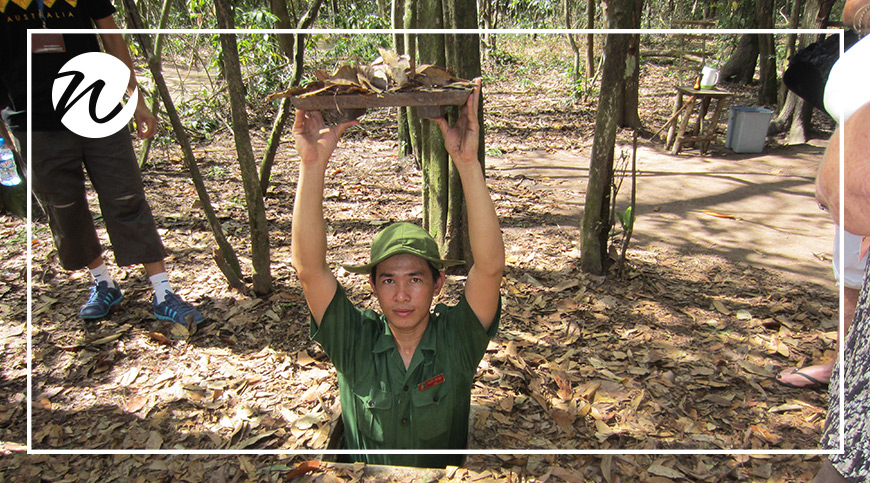Historic sites in Vietnam - Our Top 7 Must-Do's
Top 7 Historic Sites to Explore in Vietnam
Most travellers to Vietnam are drawn to the country's natural beauty and rich culture. From lush green rice fields and a stunning coastline to immense cave systems and the fascinating bustle of the Mekong Delta, Vietnam offers an abundance of experiences. The country also boasts a long history and ancient traditions, with many incredible historic sites to discover. Wendy Wu Tours takes travellers on unforgettable journeys to explore these important historic destinations.
Here are our top 7 historic sites in Vietnam, covering the south, central, and northern regions'each of which you can explore on a Vietnam tour with Wendy Wu Tours.
Cu Chi Tunnels
The region of Cu Chi shows little evidence of war on the surface, but if you head underground, you'll find a whole network of tunnels that provide a glimpse into the reality of a war-torn country. Located a short drive from Saigon, the Cu Chi Tunnels housed Viet Cong troops, who used them to plan and execute attacks, transport soldiers, and store supplies.
The Cu Chi Tunnels are part of a massive open-air museum, with over 120km of underground tunnels, trapdoors, living areas, kitchens, storage facilities, an armoury, hospitals, and command centres. If you visit this popular tourist destination, you'll have the chance to crawl through some of the tunnels yourself.
Royal Tombs in Hue
You can't explore the historic sites in Vietnam without visiting some of the royal tombs in Hue. Hue was the imperial capital of the Nguyen Dynasty between 1802 and 1945. Sadly, the city suffered significant damage during the Vietnam War, and many historic sites were bombed. However, the history of Hue is gradually being restored, and so are its iconic royal tombs.
Minh Mang, Tu Duc, and Khai Dinh are the three most popular tombs to visit, with the oldest dating back to the early 19th century. The tombs boast magnificent architecture, with courtyards featuring elephants, horses, and mandarins, as well as pavilions and temples to worship the emperor's soul. Each tomb was designed by the emperor himself, so they reflect the unique personality of the ruler. For example, Minh Mang's tomb reflects his strict adherence to Confucianism through its formal Chinese style and symmetry.
Tomb of Khai Dinh, Hue
Royal Tomb of Minh Mang, Hue
My Son Cham Ruins
Once a valley dedicated to worship, the My Son Cham Ruins are home to temples and the burial grounds of the royal Champa people. The towers were built between the 7th and 13th centuries and are located around an hour's trip from Hoi An and Danang. This spectacular site became a UNESCO World Heritage site in 1999.
Today, only a third of the temples remain standing, but the ones that are still intact, surrounded by jungle and streams, are truly magnificent. Standing amongst them with Cat's Tooth Mountain watching over you is an experience you'll never forget.
Cham Ruins at My Son
Imperial Citadel, Hue
The Nguyen Emperors made the Imperial Citadel in Hue their home and the centre of all their important business activities. Built in the early 1800s, the massive stone fortress spans an area of 6km, with walls up to 10m thick. Inside, you'll find open courtyards filled with beautiful gardens and private apartments.
The citadel was almost completely destroyed by the French in the late 1940s and became a battle site in 1968. Today, less than a third of the inner palaces and apartments remain, but what's still standing has been restored to its former glory.
Restored Glory of the Imperial Citadel, Hue
Hoi An Old Town
A great way to experience authentic Vietnam is by wandering through the much-loved old town of Hoi An. Small enough to explore on foot, it has a much slower pace compared to the bustling bigger cities. If you're after tradition, this is the place for you!
The shops, temples, markets, and riverside have all been preserved to maintain the traditional architecture. A great way to explore this is on a cyclo tour. The nightlife in Hoi An is relaxed, with happy hour starting as early as 4pm, and plenty of local spots where you can enjoy a delicious meal or drink.
Shophouses along the riverside in Hoi An
Lanterns in Hoi An Old Town
Temple of Literature, Hanoi
The Temple of Literature was not a religious landmark, as the name suggests, but rather a place of study. Originally built as a university, it now serves as a memorial to education. The school only accepted the most prestigious students from elite and royal families.
With a succession of ancient courtyards and temples, as well as immaculate gardens, the complex is truly beautiful. Today, you can admire the well-maintained traditional-style buildings and imagine walking through the gardens as a student.
Temple of Literature, Hanoi
Ho Chi Minh Mausoleum
Deep within the marble structure of Ho Chi Minh's Mausoleum lies the final resting place of the revolutionary leader himself. This iconic site in Hanoi is a popular tourist highlight, where visitors come to pay their respects to 'Uncle Ho'. Remember to dress appropriately and conservatively when visiting.
The Imposing Ho Chi Minh Mausoleum, Hanoi
If you're keen to travel through Vietnam and explore these incredible locations, visit our website to see the full range of Classic, Immerse Yourself, and Deluxe Collection tours to Vietnam.


.png)